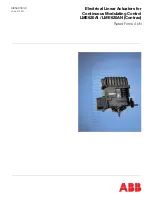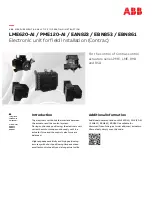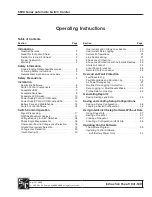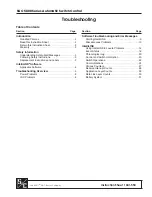
Control and function reference guide
TECH SPECS
Width......................6hp
Depth, Max.............23mm
Current Draw
Quiescent...............+/-37mA
Peak......................+/-39mA
SIGNAL LEVELS
All inputs can be safely overdriven
without phase reversal. Inputs accept
all nominal modular voltage levels.
Attenuator input headroom is ~1.2V
below/above +/- rail voltage. Mixer
output headroom is ~0.7V
below/above +/- rail voltage.
Minimum saturation level using
trimmers is r/-3.8V. Maximum
is r/-10V.
Out of range CV levels produce a
bipolar compression and offset effect
on the saturated signal.
DC input impedance: ~100kOhms
Output impedance: ~1kOhms
Thank you for purchasing the Steady State Fate MIXMODE.
Utilizing some of the best performing components available, MIXMODE defines a new level of quality standard at an affordable price. MIXMODE is a very high
fidelity quad precision attenuator, inverting attenuator, mixer, adder/subtracter, signal polarity/level indicator and unique user configurable bipolar saturater.
The high grade components provide very low noise and distortion as well as low offset voltage, exhibiting very low error as an adder subtracter and other
precision duties. MIXMODE is assembled on a 4-layer PCB which provides superior isolation from line noise.
Please read this manual at least once and use it as a reference to get the most out of MIXMODE. Enjoy!
1
8
5
INPUT
There are four inputs to MIXMODE. They are DC coupled, meaning that both audio and control voltage signals can be processed by the attenuator and
inverter . And through the mixer. These inputs are immune to phase reversal and exhibit slightly higher input headroom than most eurorack modules.
ATTENUATOR
There are four attenuators, each providing a level control for your signals. Signals will be fully silenced when this control is turned all the way to the left.
Signals will be unaffected when this control is turned all the way to the right. However, MIXMODE will buffer your signal, allowing it to drive at least four
destinations without signal degradation. Actual number may vary depending on the destination’s input impedance.
2
3
NORMAL/INVERTED SWITCH
There are four Normal/Inverted switches. NM is short for Normal or unaffected and INV is short for Inverted. This function will invert the polarity of your
signal, flipping it along the horizontal axis at 0V (ground potential). When processing control voltages or audio, you can quickly and alternatively know
the polarity setting by viewing the RGB indicator for the respective channel. For adding and subtracting applications, use NM to add and INV to
subtract the respective signals in the mix.
2
3
4
5
6
7
1
MIX/ATTENUATOR OUTPUT SWITCH
This switch only applies to channel 4 of MIXMODE. It determines the function of the channel 4 output. When in Attenuator mode (ATT), this output functions like
the other outputs and specifically as channel 4’s attenuator output. When switched to MIX mode, this output becomes the total mix of all four channels of
MIXMODE. If the other channel’s output jacks are used, the PCB jumper section as explained on page 2 will determine if that channel is included in the mix.
Like the individual attenuator sections, the mix is provided by a high bandwidth, high slew rate op amp. This device also provides higher headroom than most
eurorack modules so be careful when feeding the output into other devices - as they may overdrive an input, even if the total mix is not clipping. The max
headroom of the mixer is approximately 0.7V below/above the +/- rails and will depend on the actual rail voltage - which can sag depending on supply loading.
The mixer is optionally fed into two selectable circuits. One is the clean/high headroom just explained and the other is a unique and colorful user configurable
saturater. See and page 2 for details.
OUTPUT
There are four outputs, each is numbered in reference to the respective input. This is where the buffered and processed signal is available for each channel.
There are two optional actions pertaining to the mix that will occur when a jack is patched into outputs 1-3. The options are that (A.) the signal remains in the
mix and (B.) the signal is removed from the mix. These options are selected individually for channels 1-3 via PCB jumpers. See page 2 of this manual for details.
Output 4 provides two functions. See for more information on output 4’s functioning. Output headroom is ~0.5V below/above the +/- rail voltage.
RGB SIGNAL POLARITY INDICATOR
There are four RGB signal polarity indicators, one for each channel. These LED light-pipes provide signal amplitude and polarity indication via a three color
viewing system.
While in normal mode (NM), positive signals appear BLUE and negative signals appear RED. For audio rate signals, the color will shift from bright PINK to PURPLE
to CYAN. The shade of color is indicative of the signal’s offset or weight in the positive or negative regions. More blue means the signal is more positive, more red
means the signal is heavier or offset towards the negative region.
While in inverted mode (INV), processed** positive signals appear GREEN and processed negative signals appear RED. This color assignment allows for quick
confirmation that slow signals have inverted since if the indicator is red, it will switch to green and if blue, it will switch to red. The change will be obvious for
audio rate signals, which appear YELLOW when inverted mode is selected. The signals shift from dark or BLOOD ORANGE when offset or heavier in the negative
region, i.e. more red. And shift up to a LIGHT GREEN for the positive excursions, i.e. more green. You will find that the colors are quite indicative of the signal’s
behavior and a beautiful way to envision the sound :-)
**Please note this is not to be confused with the polarity of the actual input signal before processing, i.e. inverting the signal.
CLEAN/SATURATED SWITCH
This switch selects the circuitry for the total mix. Clean mode (CLN) is the natural and unaffected output of the high fidelity mixer. Use this mode for one of
the cleanest and best sounding compact mixers available. Saturated mode (SAT) switches on MIXMODE’s proprietary bipolar saturation circuitry. The
clipping threshold is independently adjusted for the positive and negative signal excursions via PCB trimmers on the back of MIXMODE. Please see page 2
for details on how to configure this setting - or leave it as is; specially tuned by SSF. The MIXMODE Expander brings the saturation adjustments to dedicated
panel controls. Additionally, the expander provides independent voltage control over all saturation parameters! More details for the saturater on page 2.
Rev Polarity Protected
RoHS & CE compliant
3
2
4
7
6
5
6
7
8
POLAR SATURATION INDICATORS
These LEDs are visual indicators of the saturater at work. They are the actual LEDs used by the saturation circuitry! The glow you see is your signal flowing
through these beauties. The brighter they are, the more of your signal is being soaked and drenched in pure saturated bliss!




















